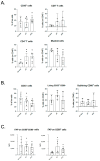Patient-Derived Explants of Osteoarthritic Synovium as Ex Vivo Model for Preclinical Research
- PMID: 40724912
- PMCID: PMC12294312
- DOI: 10.3390/ijms26146665
Patient-Derived Explants of Osteoarthritic Synovium as Ex Vivo Model for Preclinical Research
Abstract
Osteoarthritis (OA) is the most common chronic arthropathy worldwide. OA synovitis is a common feature that predicts the development and progression of symptoms and joint damage. Although the OA synovium is a target for novel therapies, the development of ex vivo models remains an area requiring further research. We aim to develop a 3D tissue explant culture model of human OA synovium that preserves the architecture and cellular heterogeneity of the original tissue in vitro. We derived tissue explant models from seven patients with OA and followed the culture for up to 10 days, assessing their morphology and cellular composition by immunohistochemistry (IHC) and flow cytometry, respectively. IHC analysis of explant cultures showed that tissue integrity and viability were maintained in our in vitro system. Furthermore, cellular heterogeneity was essentially unchanged when considering CD4+ T cells, CD8+ T cells, and myeloid fractions in our model. No significant variation was observed in the CD90+ and CD90-CD55+ fractions, which also maintained an activated state as indicated by high levels of FAP expression. An ex vivo OA synovial tissue explant model can maintain pathological tissue integrity for 10 days in culture. This simple and reliable culture system may be useful for analyzing the pathogenesis of OA disease and for the development and testing of therapeutic drugs.
Keywords: ex vivo model; explants; osteoarthritis; synovium.
Conflict of interest statement
Author Federica Pisati was employed by the company Cogentech. The remaining authors declare that the research was conducted in the absence of any commercial or financial relationships that could be construed as a potential conflict of interest.
Figures



Similar articles
-
Dorsal Subluxation of the First Metacarpal During Thumb Flexion is an Indicator of Carpometacarpal Osteoarthritis Progression.Clin Orthop Relat Res. 2023 Jun 1;481(6):1224-1237. doi: 10.1097/CORR.0000000000002575. Epub 2023 Mar 6. Clin Orthop Relat Res. 2023. PMID: 36877171 Free PMC article.
-
Human Infrapatellar Fat Pad Mesenchymal Stem Cell-derived Extracellular Vesicles Purified by Anion Exchange Chromatography Suppress Osteoarthritis Progression in a Mouse Model.Clin Orthop Relat Res. 2024 Jul 1;482(7):1246-1262. doi: 10.1097/CORR.0000000000003067. Epub 2024 Apr 19. Clin Orthop Relat Res. 2024. PMID: 38662932 Free PMC article.
-
Diacerein for osteoarthritis.Cochrane Database Syst Rev. 2014 Feb 10;2014(2):CD005117. doi: 10.1002/14651858.CD005117.pub3. Cochrane Database Syst Rev. 2014. PMID: 24515444 Free PMC article.
-
Exercise for osteoarthritis of the knee.Cochrane Database Syst Rev. 2015 Jan 9;1(1):CD004376. doi: 10.1002/14651858.CD004376.pub3. Cochrane Database Syst Rev. 2015. Update in: Cochrane Database Syst Rev. 2024 Dec 3;12:CD004376. doi: 10.1002/14651858.CD004376.pub4. PMID: 25569281 Free PMC article. Updated.
-
Systemic pharmacological treatments for chronic plaque psoriasis: a network meta-analysis.Cochrane Database Syst Rev. 2021 Apr 19;4(4):CD011535. doi: 10.1002/14651858.CD011535.pub4. Cochrane Database Syst Rev. 2021. Update in: Cochrane Database Syst Rev. 2022 May 23;5:CD011535. doi: 10.1002/14651858.CD011535.pub5. PMID: 33871055 Free PMC article. Updated.
References
MeSH terms
Grants and funding
LinkOut - more resources
Full Text Sources
Medical
Research Materials
Miscellaneous

